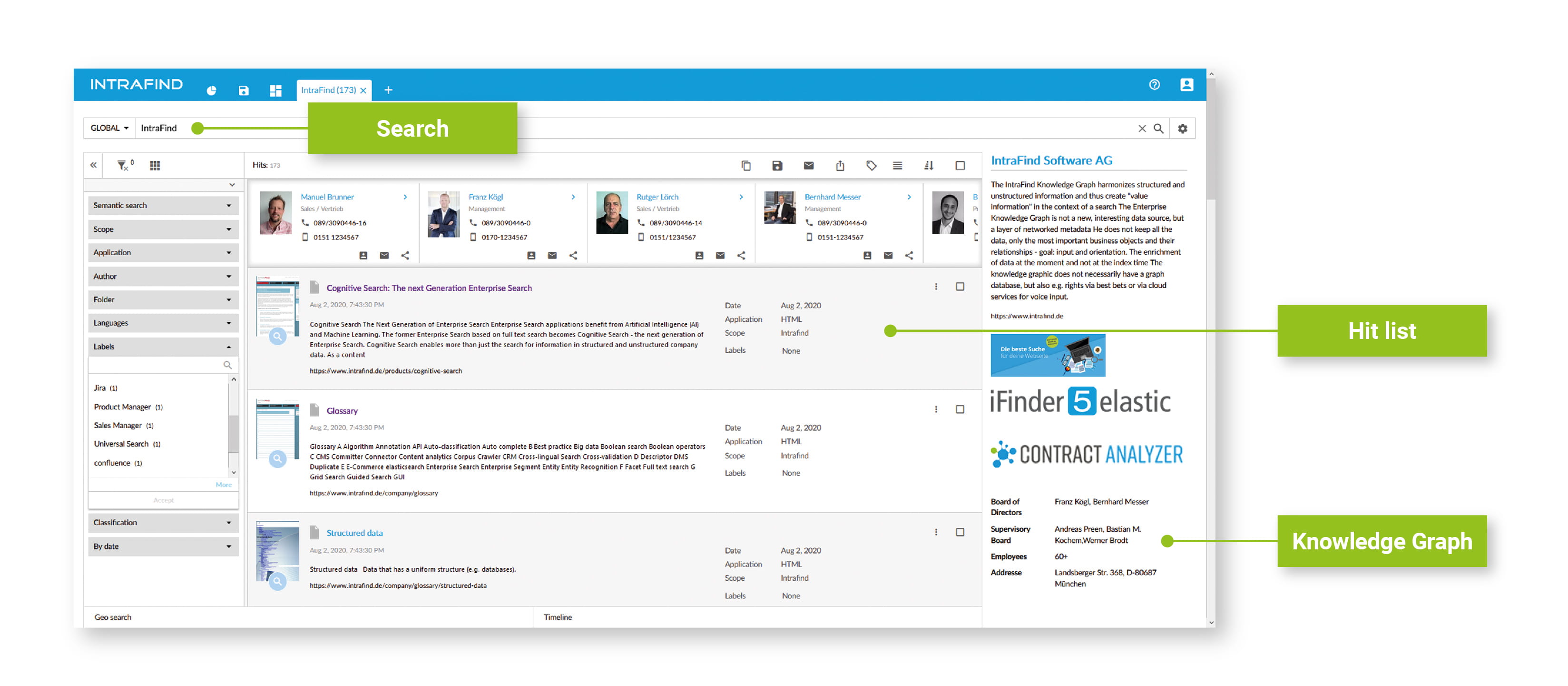
16.10.2019 | News IntraFind: How companies benefit from the Knowledge Graph
If you enter a search term in one of the current search engines on the Internet, you will receive a Knowledge Graph in addition to the hit list for certain search queries - usually as an info box to the right of the hit list. It contains the most important information about the search term and summarizes it clearly at a glance. If you are looking for a city, for example, the Knowledge Graph provides a short descriptive text, places of interest are shown, you see the location of the city on the map, you are informed about its population and the current weather conditions. Ideally, you can find the information you are looking for here without having to take a closer look at the hit list.
Companies can also benefit considerably from this technology. Therefore, the Knowledge Graph should be part of the standard features of every modern enterprise search solution today. The technical implementation of a Knowledge Graph is not necessarily ressource-intensive. Depending on the customer's requirements as to which content should be presented to the users in the Knowledge Graph, so-called best bets or graph databases with automatically or manually modeled semantic networks are used. The goal is always the same: to link structured and unstructured data with each other in such a way that real value-added information is created for the user at first glance.
The highlight: the technology can tap into any source, including all corporate sources such as the Intranet, wikis or databases, but also freely accessible content from the Internet. This can pay off in many places. IntraFind gives five examples of this:
1. At the digital workplace. With the Knowledge Graph, employees can inform themselves quickly and efficiently at the digital workplace. If, for example, they want to prepare for a customer appointment, all they have to do is enter the customer's name into the enterprise search tool and they get everything at a glance: the offer to the customer, the most important e-mails, all presentations made there, address and contact data as well as the next agreed appointments or the most important master data from the most recent customer projects.
2. With the expert search. Semantic networks can be used to extract information about employees from a user administration such as Active Directory, map important organizational structures and enrich it with additional information about the activities and skills of employees extracted from other sources, such as the Intranet. This data can be used - in consultation with the workers' council - to identify the appropriate experts in the company for each situation.
3. In customer service. Customer service staff can use the Knowledge Graph to help answer customer support questions quickly and efficiently. If, for example, a problem with a technical device arises, the graph can guide the employee through the next logical questions based on the customer's initial question and taking into account existing knowledge about the customer, and also indicate possible causes. This allows the problem to be quickly identified and solved.
4. On corporate websites. Companies can not only offer added value with the Knowledge Graph to their employees, but also to their customers and prospects - by enriching their search queries on the company website with meaningful information. This can include directions, opening hours, company news, share prices and automatically and editorially curated content links. Ideally, content that comes not only from the website itself but also from other relevant sources should also be taken into account.
5. In online shops. In online shopping, the Knowledge Graph can make it much easier for customers to find suitable products by taking their intentions into account. For example, if a family father is looking for a new car, all he has to do is type in the word "family". Using the semantic network, the Knowledge Graph then selects the most family-friendly vehicle based on features such as large load volume, suitable safety features or number of seats. It suggests particularly family-friendly features for it and provides information on similar vehicles. The Knowledge Graph can also be used to display information on current special offers and discounts.
"The great vision for cognitive enterprise search solutions is that someday they will manage completely without hit lists and provide users with the desired information simply in the form of an answer to natural language questions," says Franz Kögl, CEO of IntraFind Software AG. "With its ability to answer a search request without the user having to go deeper into the hit list, the Knowledge Graph is an important tool for human-machine interaction and a big step in this direction".
